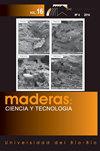The effects of bioincising by Physisporinus vitreus on cuo retention and copper element leaching in oriental spruce wood
IF 1.5
4区 农林科学
Q3 MATERIALS SCIENCE, PAPER & WOOD
引用次数: 1
Abstract
Since the treatability of Oriental spruce wood (Picea orientalis) with preservative solutions is difficult and considered as a refractory wood species, this study was intended to bring its treatability class by a bioincising process to the level of sapwood of Scots pine (Pinus sylvestris), a desirable wood species for the forest products industry. Bioincising process by Physisporinus vitreus fungus was applied to wood samples from sapwood and heartwood portions of spruce wood. The samples with two different weight loss groups (5-10 % and 10-15 %) in the bioincising process were used to detect changes in treatability with wood preservative solutions caused by the fungus. The bioincised and unincised control samples were treated with either micronized copper quat (MCQ) or alkaline copper quat type D (ACQ-D) wood preservative solutions by either dipping or vacuum methods. Following impregnation with the preservative solutions, the effects of the bioincising process on CuO (copper oxide) retention, and the leaching of Cu (copper) element were determined. The results showed that CuO retention levels increased after the bioincising process. Moreover, there was greater CuO retention in the spruce heartwood samples compared to the spruce and Scots pine sapwood samples. Amount of Cu element released from the Scots pine sapwood samples was found to be lower than that from the spruce sapwood and heartwood samples after the bioincising. process. The results suggest that the bioincising process by P. vitreus in refractory wood species might improve the treatability of wood by Cu-based wood preservatives.玻璃体物理孢子菌生物切割对东方云杉木材铜潴留和铜元素浸出的影响
由于东方云杉木材(Picea orientalis)很难用防腐剂处理,并且被认为是一种耐火木材,因此本研究旨在通过生物切割工艺将其处理等级提高到苏格兰松(Pinus sylvestris)的水平,苏格兰松是林产品工业所需的木材物种。采用玻璃体物理孢子菌对云杉边材和心材进行了生物切割。在生物切割过程中,两个不同失重组(5- 10%和10- 15%)的样品被用来检测真菌引起的木材防腐溶液的可加工性变化。将生物切割和未切割的对照样品分别用微粉铜quat (MCQ)或碱性铜quat D型(ACQ-D)木材防腐剂溶液浸泡或真空处理。在防腐液浸渍后,测定了生物切割工艺对CuO(氧化铜)保留和Cu(铜)元素浸出的影响。结果表明,经过生物刻蚀处理后,CuO滞留量增加。此外,与云杉和苏格兰松边材样品相比,云杉心材样品中的CuO滞留量更大。经生物切割处理后,杉松边材样品中Cu元素的释放量低于云杉边材和心材样品。的过程。结果表明,玻璃体假单胞菌在耐火木材中的生物切割过程可能会提高铜基木材防腐剂对木材的处理能力。
本文章由计算机程序翻译,如有差异,请以英文原文为准。
求助全文
约1分钟内获得全文
求助全文
来源期刊

Maderas-ciencia Y Tecnologia
工程技术-材料科学:纸与木材
CiteScore
2.60
自引率
13.30%
发文量
33
审稿时长
>12 weeks
期刊介绍:
Maderas-Cienc Tecnol publishes inedits and original research articles in Spanish and English. The contributions for their publication should be unpublished and the journal is reserved all the rights of reproduction of the content of the same ones. All the articles are subjected to evaluation to the Publishing Committee or external consultants. At least two reviewers under double blind system. Previous acceptance of the Publishing Committee, summaries of thesis of Magíster and Doctorate are also published, technical opinions, revision of books and reports of congresses, related with the Science and the Technology of the Wood. The journal have not articles processing and submission charges.
 求助内容:
求助内容: 应助结果提醒方式:
应助结果提醒方式:


